Bubble wrap is one of the most popular packaging materials, made from flexible, durable cells of sealed air. In this blog learn about the different bubble types and the benefits of each.
WHAT SIZE BUBBLE SHOULD YOU USE?
Bubble Wrap is available in three cell sizes; 3/16”, 5/16” and 1/2".
Large cell bubble (1/2”) is the softest, ideal for protecting and cushioning delicate items and its thickness provides a strong barrier against shock or impact, large bubble wrap is also a popular void filler. Small cell bubble (3/16”) can carry more weight than large cell and offers greater abrasion protection against dents, scratches and chips.

⚫Small cell bubble is not as soft as large bubble but can support more weight. It is the most popular, or commonly used size. 3/16” bubble has less impact or shock protection than large bubble, it is ideally used for protection against dents, chips, scrapes and scratches.
- Common Uses: Protecting glass and chinaware, jewelry, small appliances and digital items including cell phones. With its lightweight and versatile properties, moving companies often use it.
⚫Medium cell bubble is used for heavier or larger items, 5/16” bubble provides more shock absorption than 3/16” while still offering the surface protection that 3/16” bubble offers.
- Common Uses: It’s ideal for wrapping more bulky items that require thicker cushioning including artwork, mirrors and frames, heavier machinery or machine components.
⚫Large cell bubble has the greatest shock or impact resistance of all bubble sizes and therefore often used to fill the empty spaces in larger containers, or to protect grouped items. Its large, 1/2" soft cells are ideal for protecting those extra delicate items or simply just offering cushioning between layered products.
- Common Uses: Large bubble offers extra thickness void fill for large cases, cartons, containers or crates. Filling the space or void prevents the product from moving and therefore decreases product damage. Large bubble is also used to wrap and protect large pieces of furniture.
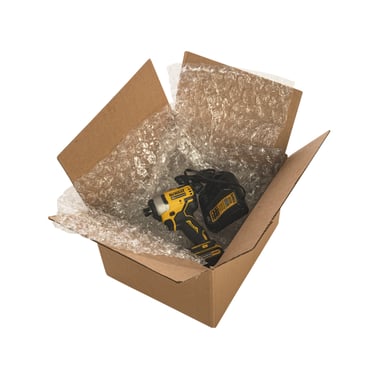
WHY IS BUBBLE WRAP SUCH A POPULAR PACKAGING MATERIAL?
Bubble wrap is one of the most common packaging materials, not only because it is so versatile, but also because it is lightweight and reusable, therefore a cost-saving and eco-friendly packaging solution. It is also transparent, offering visibility of wrapped objects without sacrificing protection.
Bubble wrap’s durability is one of the main reasons for its popularity, its cells are capable of absorbing high levels of shock or impact. That’s why bubble wrap is not only used to wrap items but also great for cushioning between layered products, or for use as void filler to protect grouped components.
As bubble wrap is one of the lightest protection materials available it keeps freight to a minimum, adding little or no extra costs. This, with the added bonus of it being reusable, makes it one of the most favoured wrapping or void-fill packaging materials for e-commerce companies that offer returns.
Custom sizing is available, you may customize the roll to the width best for your application and add perforations if desired, simply tear off the perfect size sheet, a convenient and labour-saving option at no extra cost. Having that perfect sheet size is also more cost-effective as it assists in portion control, reducing the chance of overpacking.
Bubble wrap is used in many industries as well as cabinet and metalworking shops and hardware companies to cushion and protect valuable items.
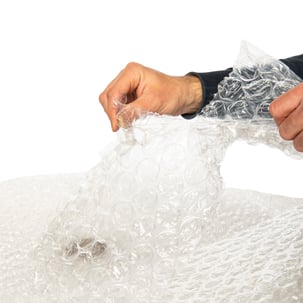
IS BUBBLE WRAP RECYCLABLE?
Bubble wrap is a type of plastic packaging that is technically recyclable. However, it cannot be recycled in the same way as traditional plastic items like bottles and containers. The reason for this is that bubble wrap is a type of plastic film, and many curbside recycling programs do not accept plastic films because they can cause complications in the sorting machinery at recycling facilities.
In these cases, bubble wrap can end up as contamination in the recycling stream, which can be detrimental to the overall recycling process.
Nevertheless, bubble wrap can still be recycled, just not in your usual household recycling bin. Instead, many grocery stores and retailers have drop-off locations specifically for plastic films, including bubble wrap. These facilities have special machines that can handle this material and recycle it properly. It's always a good idea to check with your local waste management facility or recycling center to see if they offer this service. If recycling is not an option, remember that bubble wrap is reusable and can be saved for future packaging needs, adding to its sustainability credentials.
Did you know?
SmartShield's Eco Bubble wrap contains approximately 85% recycled content.
MORE BUBBLE WRAP OPTIONS
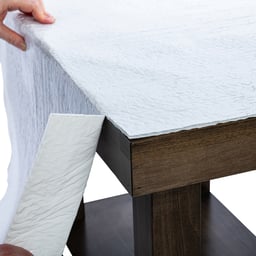
LAMINATED BUBBLE WRAP
Laminated Bubble is bubble wrap with poly film laminated to both sides of the air cell. Laminated bubble has a higher burst strength capacity than regular bubble wrap, it is commonly used when the texture of bubble cells may affect the surface of the item being packaged, ie glass, polished metal or finished wood.
Instead of being laminated between two layers of poly film, the back side of the bubble cell may be laminated to either polyethylene foam or kraft paper.
Bubble wrap laminated to foam is becoming a more popular packaging solution, available in both regular and anti-static material, laminated to your desired foam thickness. In some instances poly film laminated to bubble may not be quite protective enough, and a layer of soft polyethylene foam is recommended to prevent marking, followed by a layer of regular bubble wrap to provide the more robust cushioning required to protect the product.
-1.jpg?width=258&height=258&name=LAMENATED%20BUBBLE%20%26%20CRAFT%20PAPER-1(1)-1.jpg)
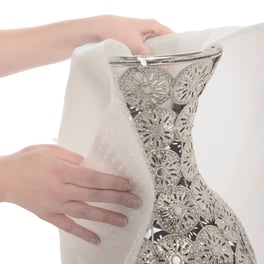
So why take the time wrapping your item twice?
Laminated bubble wrap and polyethylene foam, or laminated bubble wrap and kraft paper are available by special order, the cost is similar to purchasing the two materials individually, with the advantages of a more professionally packaged appearance, and reduced labour wrapping the product just once.
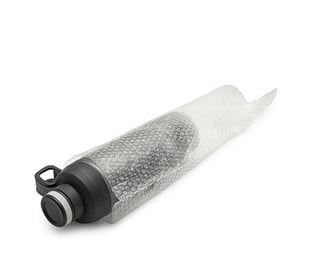
BUBBLE BAGS / POUCHES
Bubble pouches or bags are also available in standard and custom sizes, made with small (3/16”) bubble in regular or anti-static material. These bags are available as carton-packed loose bags or perforated on a roll. Choose your bubble bag from 3 design options;
1: with open end (no lip, no tape),
2: with 1” lip for easier packing tape or staple closure, or
3: with efficient 1” lip and tape (peel and seal) closure, eliminating the need for packing tape or stapling and reducing labor costs.
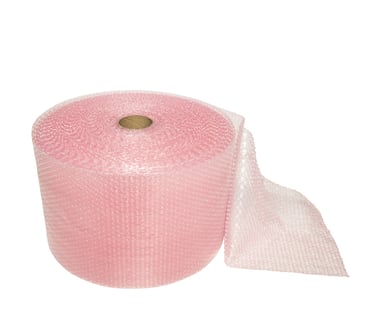
ANTI-STATIC BUBBLE
Anti-static bubble wrap is easily distinguished by its pink colour. It is used to cushion and protect delicate items including computers and sensitive electronic components from breakage, or surface scratches and chips, while also preventing damage caused by electrostatic discharge. Once wrapped in anti-static bubble wrap or sealed in anti-static bubble pouches or bags product is protected from external static electricity. Anti-static bubble is available in rolls or tubing, bags and laminated to foam.
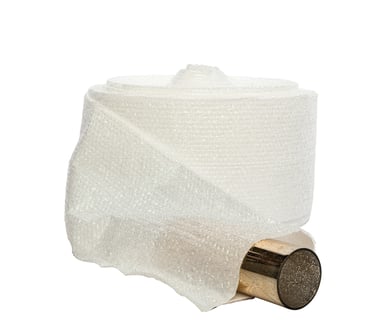
BUBBLE WRAP TUBING
Bubble wrap tubing is exactly what its name implies, a continuous sleeve of bubble wrap that has the flexibility to be cut and sealed at your desired length. Available in both regular and anti-static material, and is often laminated to polyethylene foam. These customized bubble bags or pouches are ideal for long or odd shaped items that are difficult to wrap, including wood mouldings and metal pipes or tubing.
COHESIVE BUBBLE
Cohesive bubble sticks to itself, not to your product. It is used for wrapping and cushioning, to protect large or small items from damage or abrasion. Simply wrap or completely encapsulate your product and press to seal, when your item is unpacked no residue will be left behind. Ideal for making your own pouch, simply place your product or products on the bubble and press the sides to form the desired package size. Machine application available.
THERMAL BUBBLE
Thermal bubble, or metalized bubble wrap insulation, is made from metalized polyester, it is used to cushion and protect perishable items during transit. This wrap helps to insulate to prevent temperature change, and it can be used to keep items warm or cool during transport temporarily. It is also used as a protective moisture or humidity barrier for short-term shipments of plants, foods and medicines. Thermal bubble wrap is available in rolls or pouches.
BUBBLE WRAP OR FOAM PACKAGING?
Whether you choose to use bubble wrap or foam packaging, both materials are lightweight and have fantastic protective capabilities. Bubble wrap has a more robust cushioning, offering higher impact resistance but may leave marks on reflective, shiny or polished surfaces. While foam is generally thinner, taking up less packaging space, allowing you to fit more items in the carton and also offering characteristics more suitable for delicate surface protection.
FUN FACTS ABOUT BUBBLE WRAP
◼️Bubble wrap has been used as a packaging material for over 60 years, it was originally invented in 1957 by trapping air between 2 shower curtains, creating air cells.
◼️Alfred Fielding and Marc Chavannes created bubble wrap as 3D, textured wallpaper or household décor, that unfortunately was unsuccessful, it was then marketed as insulation for greenhouses.
◼️Bubble wrap is still used for greenhouse insulation today but in 1960 bubble wrap was first introduced as its most common use; protective packaging material, and first used by IBM to protect computers during shipment.
◼️Bubble wrap is produced in 52 countries, and used to ship billions of products damage-free worldwide. Enough bubble wrap is produced each year to wrap around planet earth a minimum of 10 times.
Don’t forget to celebrate bubble wrap appreciation day: the last Monday of January each year.
BUBBLE WRAP IS NOT ONLY USED AS A PACKAGING MATERIAL:
◼️Some people use bubble wrap as insulation, simply wrap it around pipes to prevent them bursting from a freeze.
◼️Others use bubble to line the glass on their greenhouses to retain some heat in the winter months, some even line the windows of their home, or insulate their dog kennels with it! Bubble is sometimes used by campers, not only for a layer of cushioning for a more comfortable night, but also to protect them from moisture from the ground, or if its really cold even as an extra blanket.
◼️Bubble has become a popular stress reliever. Research shows it can help reduce stress, anger & anxiety; popping bubbles for just 1 minute can be as relaxing as a massage lasting 30 minutes!

